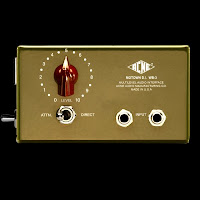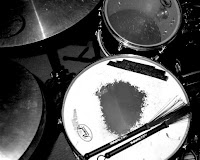I was in the studio with a guitar player recently who was having a difficult time getting the tone he wanted. As I looked at his setup, the first thing that got my attention was the maze of stomp boxes he was using.
Although that wasn't the only problem with his rig, it was a good place to start, since everything was connected more or less haphazardly.
Here's some info taken from
The Ultimate Guitar Tone Handbook (written with the great player/composer/writer
Rich Tozzoli), that can help you get a handle on your effects.
"A couple of the common negative side effects that occur with some stomp boxes is how much they change the sound when you don’t want them to. Here’s are 4 things that can happen:
1. Tone Suck
Tone suck is a term that means the tone of your guitar changes by simply inserting a pedal in between your guitar and amp, even if it isn’t turned on. The reason this happens is because your guitar signal still runs through some of the pedal’s circuitry even without the effect switched in. That circuitry degrades the signal either by changing the frequency response a bit, or by decreasing the volume a bit. Either way, this is not something we want if we’re to maintain that great tone that we hopefully started with.
There are two answers for this:
- True-Bypass means that when the effect is switch off, the signal totally bypasses all the circuitry so the pedal has zero influence on the sound as long as it’s not switched in. This is a rather recent development in the grand scheme of pedal building (since about the late 90’s) and just about all boutique pedal manufacturers use True Bypass as a sales feature these days.
One of the problems with true-bypass is that it gives the illusion that the volume and tone of the signal won’t ever change, but that’s not necessarily true. If you have a 15 foot cable from your guitar to your pedalboard, a one foot cable between each of your 15 stomp boxes, and another 15 foot cable to your amp, that’s 45 combined feet of cable, which will degrade your signal! There are ways around this with buffers (a unity gain amplifier) and loop-switching systems like the ones mentioned above, but many players never consider the consequences of just what could happen by the simple fact of connecting all those pedals together.
2. Noise Buildup
The next problem that happens with effects in the signal chain is the noise buildup that occurs when you switch them on (or even when they’re switched off if they don’t have true bypass). This can be anywhere from a slight escalation in the noise floor to the sound of a full-on hurricane, depending upon the gain of the device or devices. There are three reasons why this happens.
- Each device adds a bit of it’s own inherent noise. Some devices are designed better than others (they’re usually more expensive as a result) and keeping the noise floor down is one of the byproducts of a better design.
- The type of power being used. Although many effects can run on a 9 volt battery, they’re actually designed for 12 volt use. If you use an external AC supply, the noise level can drop considerably. Be aware that the noise floor can also rise in some pedals as the voltage drops from a weak battery.
- The input stage of the amplifier. A typical amp input stage is looking for the relatively small signal coming directly from a guitar, which it will then boost up as much as 50 times. If the gain from a pedal is cranked up, it will still be boosted by that 50 times despite where the volume control is set at on some amps. This means that your noise floor just went down the drain.
3. The Wrong Effects Order
There are two things that will directly affect how your effects interface with your amp; the effects order and gain staging. Effects order means the order that each pedal appears in the the signal chain between the guitar and amplifier. There are several schools of thought on effects order, and they each have a different result.
School Of Thought #1
This effects chain is the order generally recommended by most of the pedal gurus. There are several rules that make up this order:
- Any distortion pedal must come first right after the guitar. The exception is if you’re using a compressor pedal, which will be first in the chain. Do not put a volume pedal first, as this can alter the way a compressor or distortion pedal sounds.
- Any modulation or tone devices like wahs should come next. This enables you to keep the sustain coming from your distortion or overdrive devices and alter an already harmonically rich signal.
- Delays come almost last in the chain, since you want to be delaying your already effected signal.
- A volume pedal comes either last in the chain, or directly in front of any delay.
- In situations where a pedal is providing a lot of clean gain, that will come last in the chain so as not to overload any of the other pedals.
 |
| Effects Order #1 |
So a typical effects order might go something like:
compressor --> distortion --> wah --> chorus --> delay --> volume pedal (see the graphic on the left)
While this might not be the quietest order, it does sound really good because any distortion, overdrive, or sustain is being affected by the effects that come behind it.
School Of Thought #2
If we’re talking about recording, we may want the least amount of noise going into the amp. With that in mind, there are two rules in this scenario:
- The noisiest pedal goes last in the chain before the amp.
- The one with the most gain goes last before the amp.
The reason for both of the above points is simple; if the noisiest pedal is first in the chain, that noise will be affected and amplified further by every other pedal in the chain that you switch on. Same with the pedal with the most gain; if it’s at the beginning of the chain, it could possibly overload any other effect that comes after it, since most pedals only want to see a typical guitar signal and nothing greater (see Figure 4). Also, any noise caused by increasing the gain on a pedal will be amplified downstream by any other pedal switched on.
Generally, you’ll try to keep the basic order as in School of Thought #1 in order to be sure that any distortion or sustain is affected by the effects placed later in the chain. That being said, this order won’t sound the same as Order #2, especially if a distortion pedal is placed last in the chain (which isn’t recommended) because of its gain, so it might not be for everyone.
4. Improper Gain Staging
Proper gain staging means adjusting the gain of each effects device to keep the noise at it’s lowest and prevent overloading of any device after it. Since almost all pedals have output gain controls these days, the best way is to adjust all the output controls so the gain is exactly the same whether they’re switched on or off. If you’re running a distortion or overdrive pedal, put that last in the order, and increase the output level of that one pedal up to the sound that you like.
If you follow the above suggestions, you’ll find that your signal chain should clean up quite a bit and your recordings should benefit greatly as a result."
 The Fender Stratocaster is probably the most popular guitar in the world thanks to its comfortable body contour, sound and versatility. Through the years, the Strat has been made from lots of different woods, but what happens if it's made of some other material? What if that material was cardboard?
The Fender Stratocaster is probably the most popular guitar in the world thanks to its comfortable body contour, sound and versatility. Through the years, the Strat has been made from lots of different woods, but what happens if it's made of some other material? What if that material was cardboard?

































